Study on Crack Development of Concrete Lining with Insufficient Lining Thickness Based on CZM Method
Abstract
:1. Introduction
2. Study on Failure Mechanism and Crack Propagation of Concrete under Compression
2.1. Study on Crack Propagation of Concrete
2.2. Study on Cracking of Different Concrete Strength Grades
3. Study on Crack Propagation of Tunnel under Two Different Lining Thicknesses under Gradual Loading
3.1. Model Establishment
3.2. Fracture Behavior
3.3. Statistics of Cracks
4. Conclusions
Author Contributions
Funding
Institutional Review Board Statement
Informed Consent Statement
Data Availability Statement
Conflicts of Interest
References
- Zhang, D.X. Essential issues and their research progress in tunnel and underground engineering. Chin. J. Theor. Appl. Mech. 2017, 49, 3–21. [Google Scholar]
- Xu, G.W.; He, C.; Chen, Z.Q.; Liu, C.K.; Wang, B.; Zou, Y.L. Mechanical behavior of secondary tunnel lining with longitudinal crack. Eng. Fail. Anal. 2020, 113, 104543. [Google Scholar] [CrossRef]
- Wu, X.Z.; Jiang, Y.J.; Wang, J.H.; Masaya, K.; Taniguchi, T.; Yamato, T. A New Health Assessment Index of Tunnel Lining Based on the Digital Inspection of Surface Cracks. Appl. Sci. 2017, 7, 507. [Google Scholar] [CrossRef] [Green Version]
- Zhang, X.P.; Jiang, Y.J.; Sugimoto, S. Seismic damage assessment of mountain tunnel: A case study on the Tawarayama tunnel due to the 2016 Kumamoto Earthquake. Tunn. Undergr. 2018, 71, 138–148. [Google Scholar] [CrossRef] [Green Version]
- Zhang, S. Study on Influence Mechanism of Lining Defects and Bearing Capacity of Highway Tunnel Lining. Ph.D. Thesis, Lanzhou University, Lanzhou, China, 2020. [Google Scholar]
- Zhang, X. A Research on the Impact of the Voids behind Lining and Lining Thickness Deficiencies on the Safety of a Double-arch Tunnel Structure. Ph.D. Thesis, Beijing Jiaotong University, Beijing, China, 2018. [Google Scholar]
- Gong, Y.P. Study on the Tunnel Structure Safety under the Impact of the Lining Thickness Deficiency. Ph.D. Thesis, Beijing Jiaotong University, Beijing, China, 2019. [Google Scholar]
- Zhang, S.L. Study on Health Diagnosis and Technical Condition Assessment for Tunnel Lining Structure. Ph.D. Thesis, Beijing Jiaotong University, Beijing, China, 2012. [Google Scholar]
- Feng, G. A Study on the Structure Security of Lining—Based on the Influences of Insufficient Lining Thickness and the Voids Existing at the Back of Lining. Ph.D. Thesis, Beijing Jiaotong University, Beijing, China, 2013. [Google Scholar]
- Zhang, H.Z.; Xu, Y.D.; Gan, Y.D.; Chang, Z.E.; Schlangen, B.Š. Combined experimental and numerical study of uniaxial compression failure of hardened cement paste at micrometre length scale. Cem. Concr. Res. 2019, 126, 105925. [Google Scholar] [CrossRef]
- Zhang, H.Z.; Xu, Y.D.; Gan, Y.D.; Chang, Z.E.; Schlangen, B.Š. Microstructure informed micromechanical modelling of hydrated cement paste: Techniques and challenges. Constr. Build. Mater. 2020, 251, 118983. [Google Scholar] [CrossRef]
- Zhang, H.Z.; Xu, Y.D.; Gan, Y.D.; Chang, Z.E.; Schlangen, B.Š. Experimentally validated meso-scale fracture modelling of mortar using output from micromechanical models. Cem. Concr. Compos. 2020, 110, 103567. [Google Scholar] [CrossRef]
- Lackner, M.H.A. Crackingin Shotcrete Tunnel Shells. Eng. Fract. Mech. 2003, 70, 1047–1068. [Google Scholar] [CrossRef]
- Zhang, C.P.; Zhang, X.; Feng, G.; Zhang, D.L. Analysis of influence of insufficient lining thickness on tunnel structure safety. Mod. Tunnel Lining Technol. 2017, 54, 137–169. [Google Scholar]
- Wang, C.J.; Lei, M.F.; Peng, L.M. Safety evaluation model and method of tunnel disease structure. J. Railw. Sci. Eng. 2011, 8, 73–77. [Google Scholar]
- Wang, H.L.; Li, N.; Chu, F.P. Effect of lining thickness lack on lining safety for highway tunnel. J. Traffic Transp. Eng. 2009, 9, 32–38. [Google Scholar]
- He, C.; Tang, Z.C.; Wang, B.; She, J. Study on Effects of Stress Field for Bearing Capacity in Defect Tunnel. Chin. J. Undergr. Space Eng. 2009, 5, 227–234. [Google Scholar]
- He, C.; Liu, C.K.; Wang, S.; Zhang, J.; Lu, D.; Ma, G. Influence of Crack Number on Mechanical Properties of Shield Tunnel Segment Structure. China J. Highw. Transport. 2018, 31, 210–219. [Google Scholar]
- Zheng, Y.Y. Study on the Generating Mechanism of Crack and Safety Assessment of Tunnel Lining. Ph.D. Thesis, Central South University, Changsha, China, 2014. [Google Scholar]
- Ansell, A. Investigation of shrinkage cracking in shotcrete on tunnel drains. Tunn. Undergr. Space Technol. 2010, 25, 607–613. [Google Scholar] [CrossRef]
- Amiri-Rad, A.; Mashayekhi, M.; van der Meer, F.P. Cohesive zone and level set method for simulation of high cycle fatigue delamination in composite materials. Compos. Struct. 2017, 160, 61–69. [Google Scholar] [CrossRef] [Green Version]
- Shor, O.; Vaziri, R. Application of the local cohesive zone method to numerical simulation of composite structures under impact loading. Int. J. Impact Eng. 2017, 104, 127–149. [Google Scholar] [CrossRef]
- Patryk, R. Stability and failure of compressed thin-walled compositecolumns using experimental tests and advanced numerical damage models. Int. J. Numer. Methods Eng. 2021, 122, 127–149. [Google Scholar]
- Research Institute of Highway Ministry of Transport of China. Testing Methods of Cement and Concrete for Highway Engineering; JTG 3420-2020; Research Institute of Highway Ministry of Transport of China: Beijing, China, 2020. [Google Scholar]
- Zhang, H.; Zhang, H.W.; Su, F. The Introduction and Application of Cohesive Zone Model on Asphalt Concrete Fracture Behavior. Appl. Mech. Mater. 2015, 744, 1320–1323. [Google Scholar] [CrossRef]
- Wu, Z.J.; Zhang, P.L.; Liu, Q.S.; Li, W.F.; Jiang, W.Z. Dynamic Failure Analysis of Reinforced Concrete Slab Based on Cohesive Element Under Explosive Load. Eng. Mech. 2018, 35, 79–90. [Google Scholar]
- Jiang, H.X.; Meng, D.G. 3D numerical modelling of rock fracture with a hybrid finite and cohesive element method. Eng. Fract. Mech. 2018, 199, 280–293. [Google Scholar] [CrossRef]
- Wu, X.L. Study on the Influence of Void behind Early Support of Highway Tunnel on Structure Safety and Crack Evolution. Ph.D. Thesis, Shandong University of Science and Technology, Qingdao, China, 2021. [Google Scholar]
- Wu, B.; Zhang, S.Y.; Yang, Y. Compressive behaviors of cubes and cylinders made of normal-strength demolished concrete blocks and high-strength fresh concrete. Constr. Build. Mater. 2015, 78, 342–353. [Google Scholar] [CrossRef]
- Ministry of Transport of PRC. Code for Design of Road Tunnel; China Communication Publisher Ltd.: Beijing, China, 2014. [Google Scholar]
- Liu, C. Experimental Investigation on Fracture Behavior of Concrete under Three Point Bending Test and Numerical Simulation. Ph.D. Thesis, Guizhou University, Guiyang, China, 2017. [Google Scholar]
- Code of China. Standard for Test Methods of Concrete Physical and Mechanical Properties; GB/T 50081-2019; Code of China Inc.: Beijing, China, 2019. [Google Scholar]
- Yang, L.Y.; Zhang, F.; Chen, S.Y.; Huanning, H.; Ziyang, W.; Changyu, L. Study on dynamic crack initiation and propagation behavior of surrounding rock of adjacent roadway. J. Min. Sci. Technol. 2021, 6, 558–568. [Google Scholar]
- Wu, X.L.; Wang, G.; Li, G.X.; Han, W.; Sun, S.Q.; Zhang, S.B.; Bi, W.L. Research on Shear Behavior and Crack Evolution of Symmetrical Discontinuous Rock Joints Based on FEM-CZM. Symmetry 2020, 12, 1314. [Google Scholar] [CrossRef]


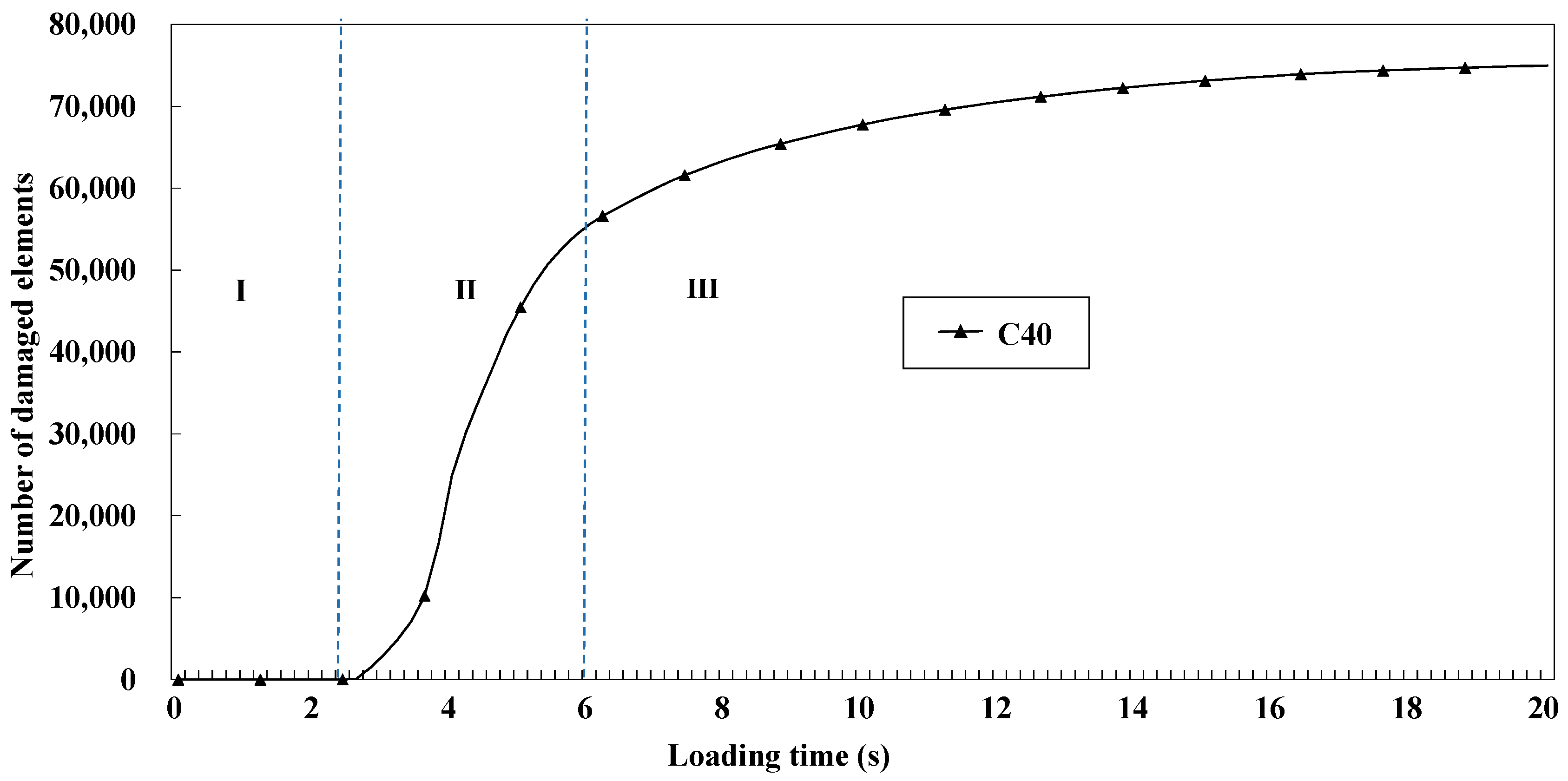
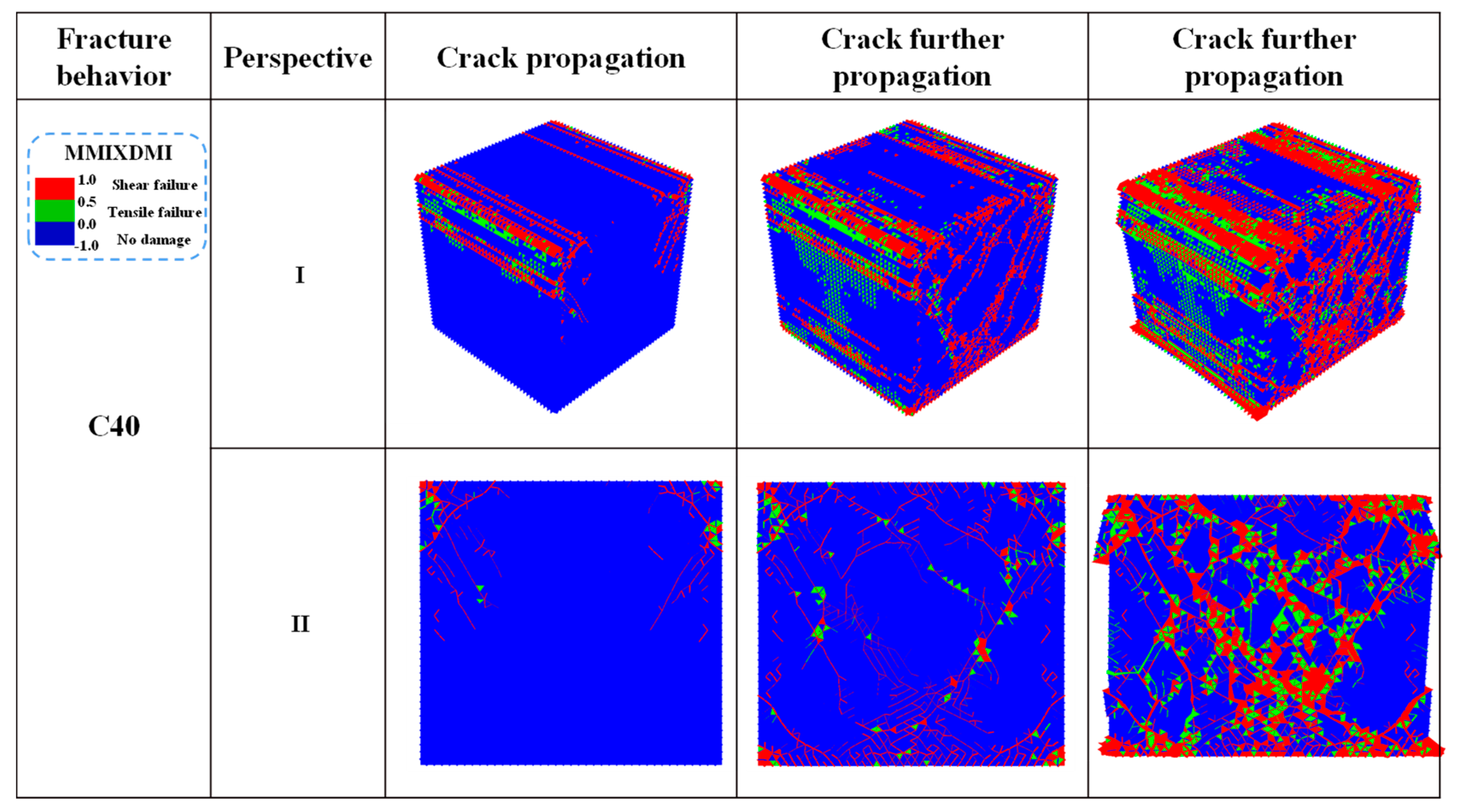
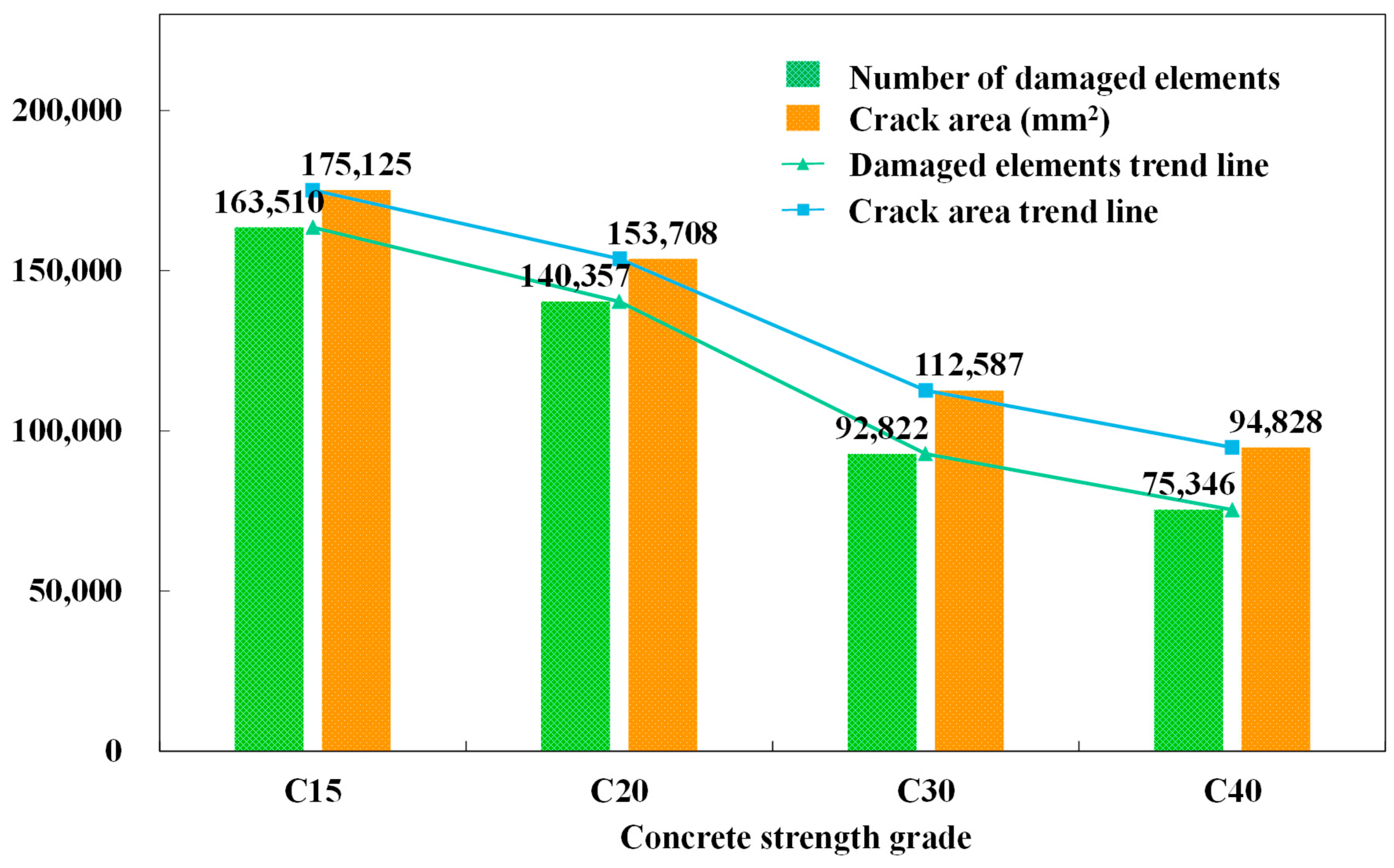
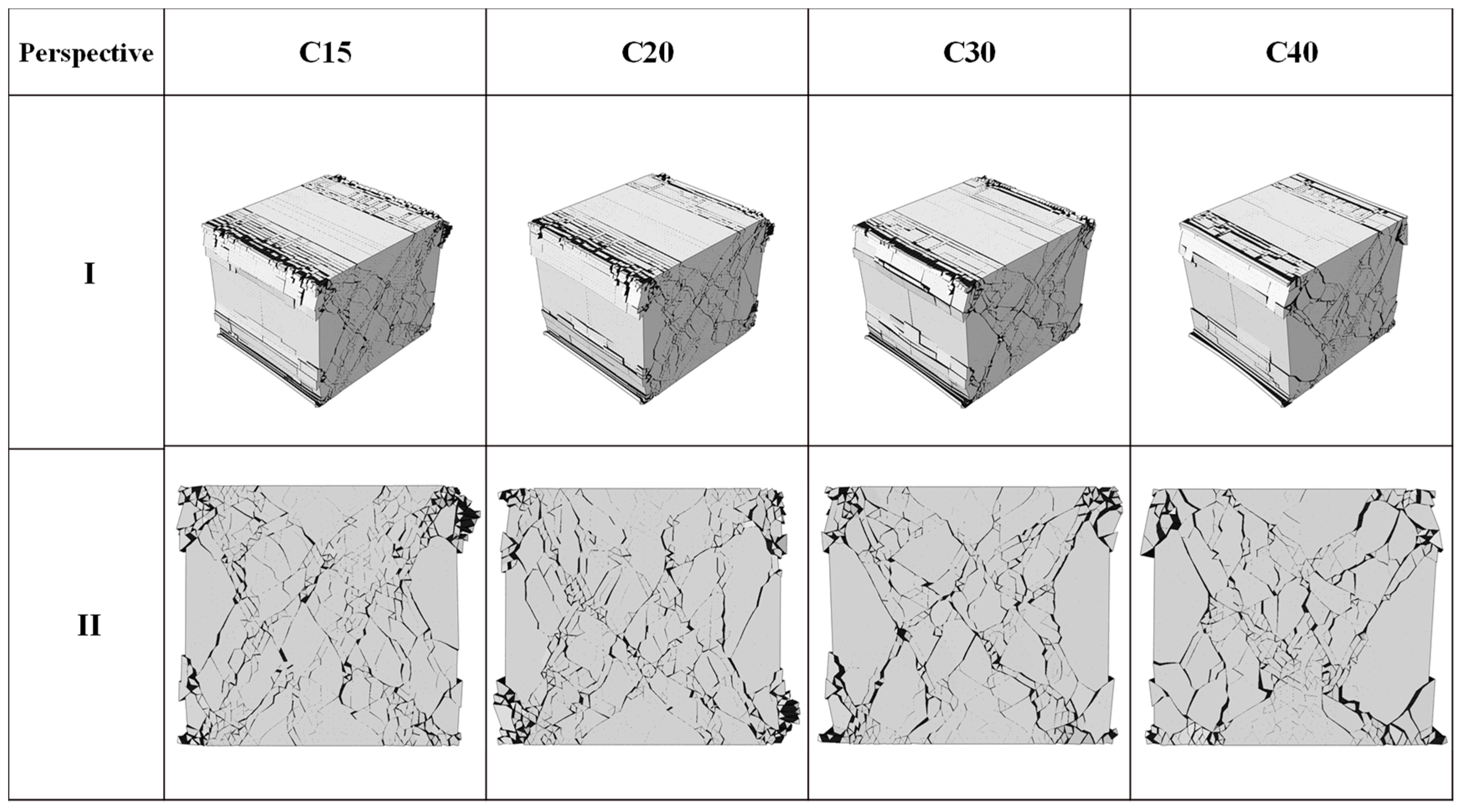
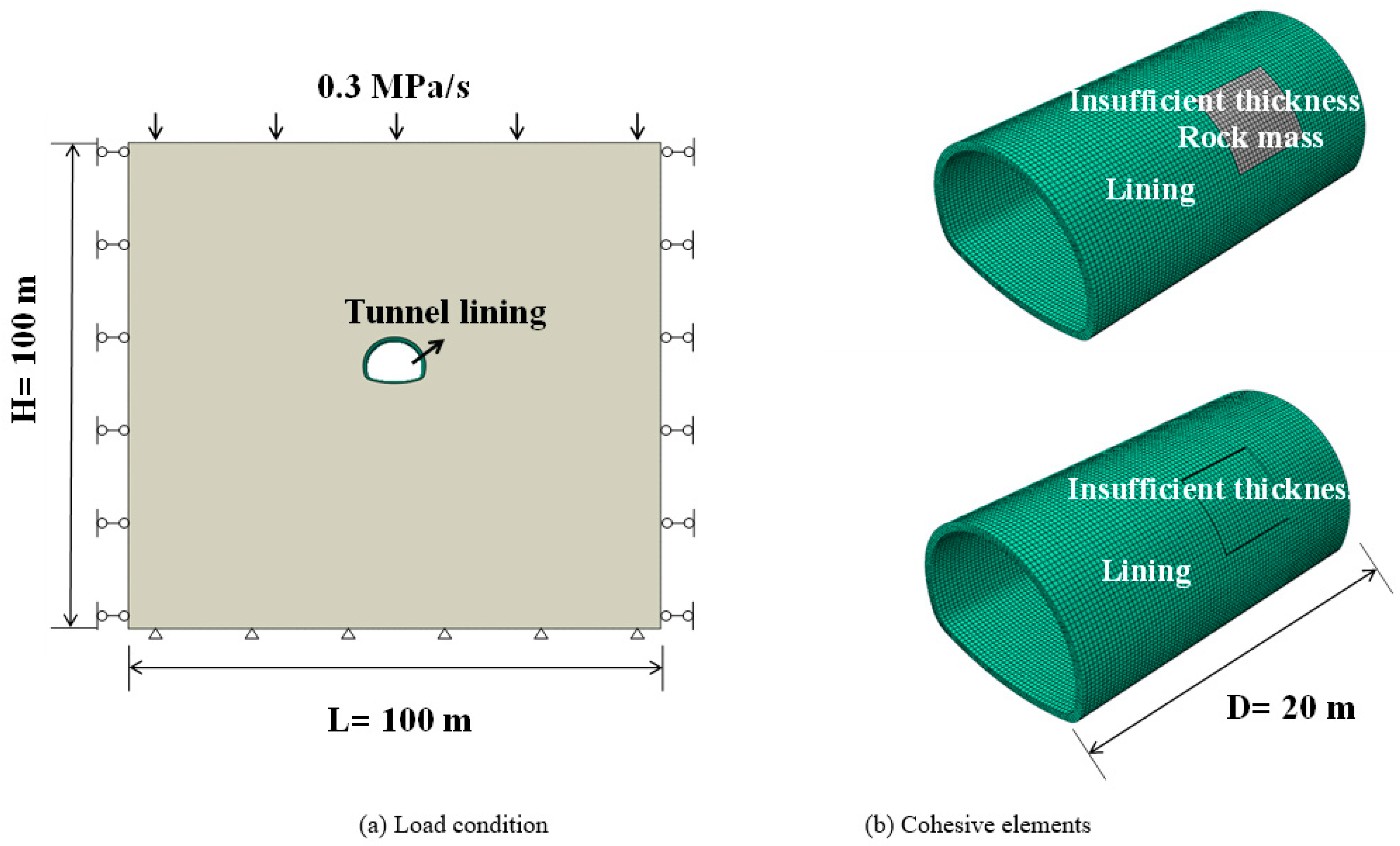
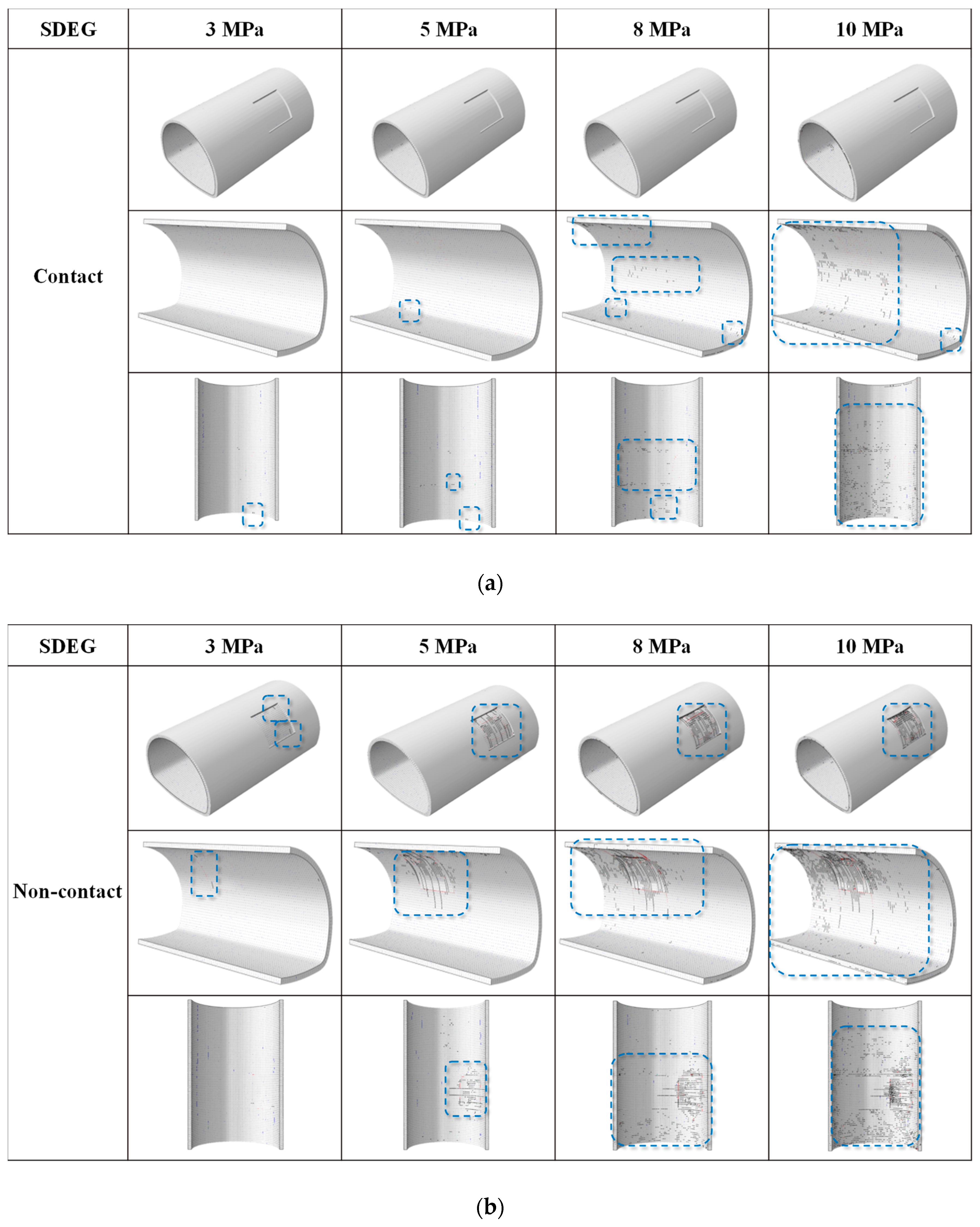

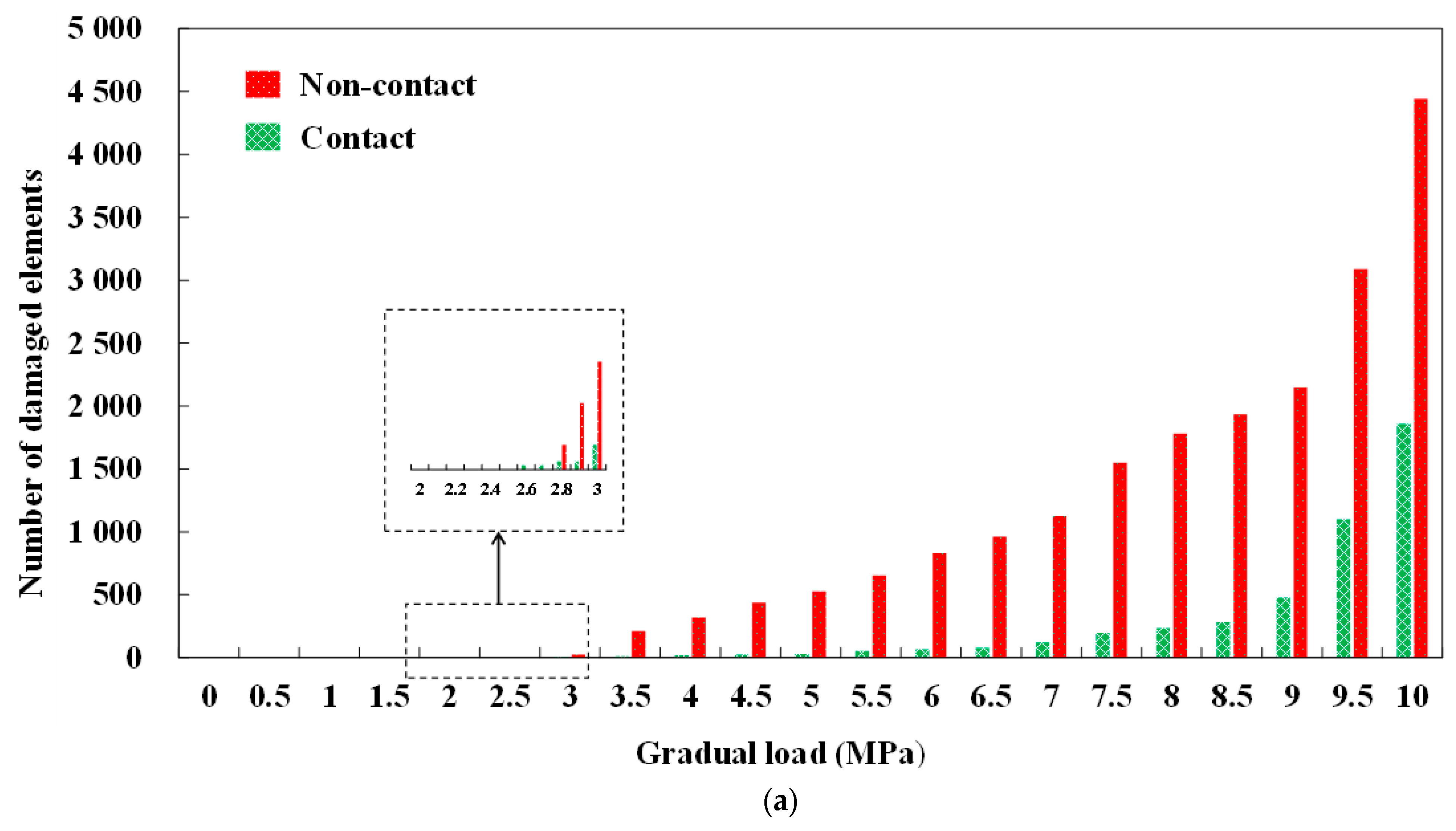


| Conditions | Concrete Strength Grade | Density ρ (kg/m3) | Elasticity Modulus E (MPa) | Poisson’s Ratio v |
|---|---|---|---|---|
| Condition 1 | C15 | 2360 | 22,000 | 0.20 |
| Condition 2 | C20 | 2370 | 25,500 | 0.20 |
| Condition 3 | C30 | 2390 | 30,000 | 0.20 |
| Condition 4 | C40 | 2400 | 32,500 | 0.20 |
| Concrete Strength Grade | Density ρ (kg/m3) | Normal Traction (MPa) | Tangential Traction (MPa) | Fracture Energy/(N/m) | |
|---|---|---|---|---|---|
| C15 | 2360 | 5 | 16 | 55 | 120 |
| C20 | 2370 | 5.5 | 18 | 65 | 135 |
| C30 | 2390 | 6.5 | 22 | 80 | 185 |
| C40 | 2400 | 8 | 30 | 100 | 200 |
| Part | Density ρ (kg/m3) | Elasticity Modulus E (GPa) | Poisson’s Ratio v | Cohesion c (kPa) | Internal Friction Angle φ (°) |
|---|---|---|---|---|---|
| Rock mass | 1800 | 1.5 | 0.35 | 150 | 20 |
| Lining solid elements | 2390 | 30 | 0.2 | - | - |
Publisher’s Note: MDPI stays neutral with regard to jurisdictional claims in published maps and institutional affiliations. |
© 2021 by the authors. Licensee MDPI, Basel, Switzerland. This article is an open access article distributed under the terms and conditions of the Creative Commons Attribution (CC BY) license (https://creativecommons.org/licenses/by/4.0/).
Share and Cite
Liu, J.; Zhang, X.; Lv, G.; Wang, K.; Han, B.; Xie, Q. Study on Crack Development of Concrete Lining with Insufficient Lining Thickness Based on CZM Method. Materials 2021, 14, 7862. https://doi.org/10.3390/ma14247862
Liu J, Zhang X, Lv G, Wang K, Han B, Xie Q. Study on Crack Development of Concrete Lining with Insufficient Lining Thickness Based on CZM Method. Materials. 2021; 14(24):7862. https://doi.org/10.3390/ma14247862
Chicago/Turabian StyleLiu, Jian, Xuesen Zhang, Gaohang Lv, Kang Wang, Bo Han, and Quanyi Xie. 2021. "Study on Crack Development of Concrete Lining with Insufficient Lining Thickness Based on CZM Method" Materials 14, no. 24: 7862. https://doi.org/10.3390/ma14247862






